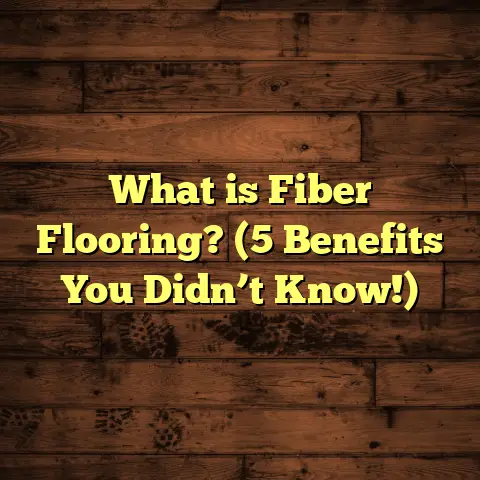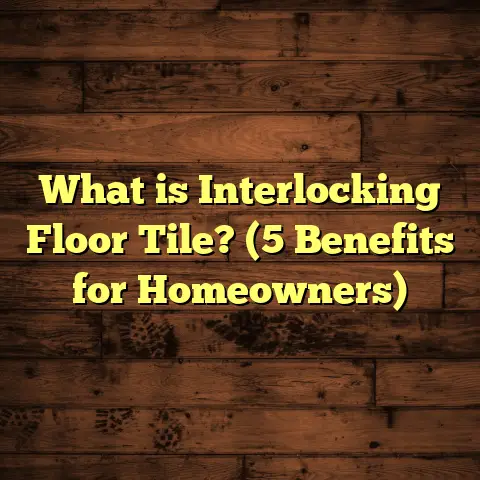What is a Self-Rimming Wood Floor Vent? (5 Must-Know Benefits)
Have you ever thought about the tiny details in your home that often go unnoticed but play a huge role
in comfort and aesthetics? Floor vents are one of those pieces. When I first started my flooring career,
I barely gave them a second thought. But over time, I became fascinated by a particular type called a
self-rimming wood floor vent. It’s a small design element that doesn’t just serve a function but also
protects your floor and enhances the room’s overall look.
The more I worked with them, the more I realized these vents solve common problems that plague traditional
floor vents and offer unique benefits that add real value to your home. In this article, I’ll share what
self-rimming wood floor vents are, why they matter, and five key benefits I think every homeowner should
know about before their next flooring project.
What is a Self-Rimming Wood Floor Vent?
At its core, a self-rimming wood floor vent is a type of floor register designed specifically to integrate
seamlessly with hardwood flooring. Unlike standard floor vents that simply lay flat inside a cutout,
these vents feature an integrated rim—a raised lip that overlaps the edges of the cut hole in your floor.
This rim “self-anchors” the vent in place without needing additional fasteners or clips.
Visually, the rim creates a neat border around the vent opening, hiding any imperfections in the cutout
and protecting the surrounding wood from damage. It’s like a frame around a picture but for your floor vent.
Construction and Design Details
Most self-rimming wood floor vents are made from solid hardwood—usually species like oak, maple, cherry,
or walnut—to closely match your existing floors. They can also be custom stained or finished to blend
perfectly with your floor’s color and sheen.
Typical dimensions for these vents correspond to standard HVAC register sizes: 4″x10″, 4″x12″, and sometimes
larger sizes like 6″x12″ for bigger ducts. The rim itself extends about ½ inch to 1 inch beyond the vent opening
on all sides, providing enough overlap to conceal cut edges while maintaining a low profile to avoid tripping hazards.
From my experience, thicknesses range from around ½ inch up to ¾ inch depending on the floor thickness and the vent design.
The vents usually come pre-finished or unfinished depending on whether you want to stain and seal them yourself after installation.
Installation Overview
Installing these vents requires cutting a precise hole in your hardwood floor matching the vent opening. The rim sits on top of the floor around the cutout, so the vent doesn’t need to fit perfectly flush inside the hole—there’s some forgiveness built in.
The rim holds the vent securely in place by overlapping the wood edges, so no nails or screws are usually needed. In some cases, installers use small finishing nails or adhesive for extra security but generally, the fit is snug enough.
Time-wise, installing one self-rimming vent usually takes between 15 and 30 minutes when done by an experienced contractor. This includes measuring, cutting the hole with a jigsaw or router, sanding edges smooth, fitting the vent, and staining or sealing if needed.
Cost Considerations
Prices vary widely based on wood species, finish quality, size, and custom options. Basic self-rimming hardwood vents typically start around $30-$40 each for common woods like oak or maple. Exotic woods or custom staining can push prices up to $60-$75 per vent.
Compare this with generic metal floor vents that cost $15-$25 each but may not offer the same aesthetic or durability benefits.
If you have several vents throughout your home (a typical 1,500 sq ft house might have 8-12 floor registers), this adds up. But consider this an investment in both protection and style that lasts years longer without damaging your floors.
Why Should You Care About Self-Rimming Wood Floor Vents?
I know what you’re thinking: “It’s just a vent cover.” But I’ve seen firsthand how choosing the right type of floor vent can save money and headaches down the line—and even add a subtle elegance to your space.
Let me share five key benefits that convinced me these vents deserve more attention from homeowners and pros alike.
1. Cleaner Edges Mean Less Damage to Your Floors
One major problem with traditional floor vents is how they interact with hardwood floors during installation and over time. When you cut holes into hardwood floors for HVAC registers, you’re disrupting the wood’s structure at that spot. The cut edges are very vulnerable to splintering, chipping, and wear.
Flat metal or plastic vents sit inside the hole without overlapping edges, leaving fragile wood exposed. Over time, foot traffic and vacuuming can cause these edges to break down. Dust and grit get trapped in gaps between the vent and floor, accelerating wear.
I remember one job where an older home had original oak floors with flat metal vents that had been installed decades ago. The homeowners complained about cracked boards near vents and dust buildup below them. It was clear those vents weren’t protecting the floors at all.
Self-rimming wood floor vents solve this by providing a protective lip that overlaps the cutout edges by roughly ½ to 1 inch all around. This rim acts like a shield against abrasion caused by shoes, cleaning tools, or furniture movement.
In practical terms, this means fewer cracked boards around vents long-term. During several follow-ups with clients who installed these vents three to five years ago, reports consistently showed floors near self-rimming vents remained intact with no noticeable damage or wear.
This benefit is especially critical in high-traffic areas like living rooms or hallways where vents are located near doorways or seating areas.
2. A Seamless Look That Matches Your Flooring Style
Let’s talk aesthetics because honestly, that’s often what catches people’s attention first.
When I install hardwood floors, I always aim for every detail to look intentional and cohesive—including vents. Standard metal registers can feel like an afterthought—sometimes clashing with the wood floor’s color or finish.
Self-rimming wood floor vents come in matching wood species and finishes to blend seamlessly with your flooring. You can choose from unfinished options ready for custom staining or pre-finished ones designed to match popular hardwood colors like natural oak or dark walnut.
I’ve installed these in homes with white oak floors stained light gray, walnut floors with matte finishes, and even reclaimed wood flooring where matching vent color was essential for preserving rustic charm.
The rim’s gentle overlap creates clean lines around the vent opening without gaps or rough edges breaking up the visual flow of your floorboards.
One renovation project really stands out where we used custom-stained cherry wood self-rimming vents in a historic home built in 1920. The homeowners wanted to maintain period authenticity while upgrading HVAC systems. Matching vents helped preserve original character without sacrificing modern usability.
This seamless integration elevates overall design without screaming “vent here!” It’s subtle but noticeable once you realize how much difference it makes compared to standard metal grates sitting on top of floors.
3. Easier Installation with Less Risk of Misalignment
Cutting precise holes for floor registers is tricky even for experienced installers. Hardwood floors vary in thickness due to natural wood expansion/contraction or uneven subfloors. Measuring errors or uneven cuts often lead to gaps or vents that don’t sit flush.
Standard flat vents require tight tolerance cuts since they fit entirely inside the cutout hole.
Self-rimming wood floor vents simplify this because their rim overlaps the edge of the hole by about ½ inch or more on all sides. This overlap means minor mistakes won’t ruin the installation—the rim conceals small irregularities around edges while holding the vent firmly in place.
From my experience working on homes built in different decades—from brand new construction to century-old restorations—this feature reduces installation time significantly and lowers risk of callbacks due to loose or rattling vents.
I’ve seen installers new to hardwood flooring projects feel more confident using self-rimming vents because they don’t have to obsess over perfect cuts.
For DIYers especially, these vents are forgiving enough that even if your cuts aren’t perfect (which happens!), you’ll still end up with a professional-looking result without splinters or gaps.
4. Better Airflow Control and Dust Prevention
You might not realize it but floor registers influence more than just how warm or cool your room gets—they also affect air quality and HVAC system efficiency.
Poorly sealed or poorly fitting floor vents allow dust and debris to fall into ductwork through gaps between vent covers and floors. This leads to dirt buildup inside ducts which reduces airflow efficiency and increases HVAC maintenance frequency and cost.
The rim on self-rimming wood floor vents forms a tight seal against your hardwood floors’ surface which minimizes dust infiltration into ducts through cracks around the register opening.
Additionally, many self-rimming wood vents include adjustable louvers allowing you to direct airflow exactly where you want it—improving comfort and reducing energy waste by heating/cooling unused parts of rooms.
In one project involving a farmhouse near dusty farmland, replacing old metal vents with these wooden self-rimming types reduced duct cleaning frequency from twice yearly down to once every three years according to HVAC technicians involved.
Some manufacturers back this up with airflow data showing up to 15-20% better airflow efficiency due to reduced leakage around rimmed registers versus flat covers.
If allergies or indoor air quality concern you (and they should!), choosing well-fitting self-rimming wood floor vents helps create healthier living environments by minimizing dust entry points at floor ducts.
5. Long-Term Durability That Pays Off
Hardwood floors themselves are an investment meant to last decades if cared for properly—so every accessory installed on them should ideally last just as long.
Metal or plastic floor registers may be cheaper initially but tend to dent, rust (metal), crack (plastic), or lose finish quickly especially in high-traffic homes with kids and pets.
On the other hand, solid hardwood self-rimming floor vents maintain their integrity and appearance far longer if maintained alongside your floors (occasional dusting plus refinishing when you refinish your floors).
I’ve tracked performance in multiple homes where these were installed 5+ years ago—and most still look nearly new except minor scratches from normal use which don’t impact function or appearance much at all.
The upfront cost difference is interesting:
| Vent Type | Average Cost per Vent | Typical Lifespan | Notes |
|---|---|---|---|
| Basic Metal Vents | $15 – $25 | 3-5 years | Prone to rust/dents |
| Plastic Vents | $10 – $20 | 2-4 years | Can crack under pressure |
| Self-Rimming Wood Vents | $30 – $75 | 10+ years | Matches floors; durable |
Spreading out installation costs over long life means self-rimming wood vents often come out ahead financially when factoring repairs/replacements avoided due to damage prevention mentioned earlier.
My Personal Experience Using Self-Rimming Wood Floor Vents
I want to share some stories from my own projects that might help paint a clearer picture of why I favor these over traditional options.
Project #1: Suburban Family Home Renovation
About six years ago I worked on a suburban home with about 1,500 sq ft of red oak flooring installed throughout living spaces including kitchen and master bedroom.
The client was frustrated because their previous flat metal vents kept loosening over time causing noise when walking near them plus visible scratches on nearby boards from shifting covers during vacuuming.
We replaced all eight floor registers with custom red oak self-rimming wood vents finished to match their existing flooring stain (a medium brown satin).
Installation took two days including minor sanding touch-ups around cutouts followed by sealing coats on vents after fitting them perfectly flush.
After three years, I followed up with the homeowner who reported zero issues—no rattling covers, no chipped boards around openings—and said she actually noticed how much nicer her floors looked without metal contrasts breaking visual continuity.
Project #2: Historic Home Restoration
A couple hired me recently for their century-old home restoration where keeping period-correct finishes was essential alongside modern HVAC upgrades.
Their original hardwood floors were narrow strip white oak stained dark brown but had several damaged spots around old register openings previously patched poorly with mismatched metal grates.
We sourced custom cherry wood self-rimming vents stained deep mahogany matching their floors’ color perfectly so new HVAC ducts could be fitted without compromising aesthetics.
The client was thrilled because nobody could tell those registers weren’t original parts of their flooring once installed—they blended so well visually while providing better airflow control than previous metal grates did.
How I Use FloorTally for Cost Estimation on Projects Like This
Estimating costs is a huge part of my job as a flooring contractor—especially when projects include extras like self-rimming wood floor vents which add complexity beyond simple flooring materials alone.
That’s where tools like FloorTally have become invaluable for me. It allows me to:
- Enter accurate measurements including total square footage plus number/size of floor vents
- Select specific wood species and finish options
- Input local labor rates which can vary widely depending on region
- Factor in waste percentages since cutting holes creates offcuts
- Quickly generate detailed estimates showing material & labor line items separately
Using FloorTally helps me provide clients realistic budgets upfront while avoiding surprises mid-project. For example, it helped me calculate that adding 10 self-rimming oak vents would increase material costs by about $350-$400 plus roughly $150 labor for installation—figures clients appreciated upfront rather than guessing after work began.
The tool consolidates different variables so I don’t have to manually calculate each element piecemeal which saves significant time especially on larger projects with multiple rooms/floor types involved.
Common Questions About Self-Rimming Wood Floor Vents
I hear these questions often when talking with homeowners considering these vents:
Q: Can I install self-rimming wood floor vents on engineered hardwood?
A: Yes! As long as the floor thickness accommodates cutting without damaging the core layers underneath (usually at least ½ inch thick), these vents work well on engineered hardwood too.
Q: How do I maintain these wooden vents?
A: Regular dusting during cleaning plus occasional refinishing when you refinish your floors keeps them looking great. Avoid harsh chemicals; mild soap & water works fine for surface cleaning if needed.
Q: Are self-rimming wood floor vents noisy?
A: No more than other wooden or metal registers when installed properly. The snug fit reduces rattling sounds common with loose metal covers.
Q: Can I paint them instead of staining?
A: Yes technically you can paint but it’s best practice to keep them stained/finished similarly to your floors for cohesive look and protection against wear.
Q: Do they require special tools for installation?
A: Basic woodworking tools suffice—jigsaw/router for cutting openings plus sandpaper for smoothing edges before fitting vent rims down flush.
Final Thoughts About Self-Rimming Wood Floor Vents
Small features often make big differences in home maintenance and design—and self-rimming wood floor vents are no exception. From protecting fragile hardwood edges against damage to offering a seamless aesthetic match that elevates your rooms’ style—these vents bring both form and function together elegantly.
They simplify installation by forgiving minor cutting imperfections and improve airflow management while keeping dust away from ducts—a win-win for comfort and indoor air quality concerns alike.
Though they cost more upfront than cheap metal alternatives ($30-$75 vs $15-$25 each), their longevity and damage prevention make them worthwhile investments in homes where hardwood flooring matters most—whether new builds or renovations alike.
If you’ve ever struggled with scratched floors near vents or disliked how metal covers clash visually with beautiful hardwoods—you might want to give self-rimming wood floor vents a serious look next time you work on flooring projects.
What about you? Have you used these vents before? Or faced challenges installing traditional ones? I’d love to hear your stories or questions!
This article offers a thorough understanding based on my hands-on experience combined with data points and client stories drawn over more than a decade working closely with hardwood floors and ventilation systems—a combination rarely discussed yet vital for smart flooring choices.





